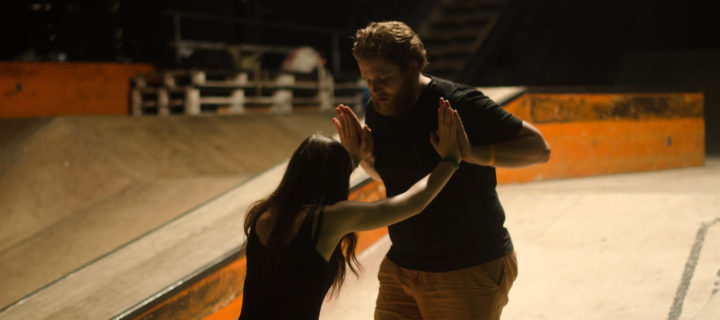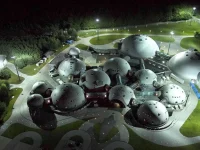The pre-game workshop tradition in Nordic larp is mostly oral, with little written material. People take part in workshops as players, then borrow and develop ideas from those experiences to construct workshops for their own larps. So I thought it might be useful to put together a method which looks at some of the different intentions and purposes that workshop activities can have, to help designers think about and plan their workshops more systematically.
The table below lists and categorizes workshop activities that I use in my own practice, or that I will use if I run a larp that requires them. The sequence of the table is the sequence in which I use these activities: ie. first working on the players themselves, then working with them on their characters; start with warmup, move on to impro basics if required, and so on. There may be requirements to move back and forth (eg. perhaps a re-warmup will be needed partway through, or meta-techniques may be practised again in-character), but it’s this general direction.
In practice you may use workshop activities that have more than one purpose: this may be desirable both for conciseness and for helping to reinforce the activity impact upon players. For example, flashback scenes can be used to calibrate players’ understanding of relationships with each other. Or the way to teach a particular technique could also serve as a trust exercise.
I’ve given an example activity for each aim, but of course there are many different ways of achieving all of them: some will be more appropriate for some larps than for others; and you’ll have your own favourites. The useful Workshop Handbook site has a categorized collection of activities which give plenty more examples.
A few of the items talk about ‘calibration’. This is a very important larp-preparation concept, introduced by Martin Nielsen (2014). The short definition is: “all participants adjust their interpretation of a phenomenon, so that all participants have more or less the same interpretation.” (Where I take “phenomenon” to mean something like: an aspect of the culture being portrayed/experienced in the larp.)
* Safety exercises aren’t always included in workshops; indeed they’re quite rare in some larping cultures. But I personally feel that there should always be at least a minimum safety brief.
Details
Spelling each of these out in more detail:
- Introduction– the frame through which players enter the workshop and the game. Welcome them, check off names if appropriate, tell everyone what the game is that they’re about to play, tell them that now they are in the pre-game workshop.
- Practicalities – those useful things players need to know so they can be comfortable in the space. Where are the bathrooms, where are the exits, can they eat and drink, how long will the workshop and the game last, will there be breaks… etc.
- Structure and purpose – explain why this game is preceded by a workshop, and what will be achieved during it. You may want to go into detail about the workshop activities – more likely, you’ll just give a general picture. (Or you may want to keep the activities secret for now, so the players aren’t expecting them.)
- Warmup – important to get players relaxed, disinhibited, and moving freely. There are lots of great warmup exercises, such as Penguins and flamingos, Human knot, Jump in jump out, Shake hands… Choose exercises that are appropriate for your number of players and for the space that you’re using.
- Impro basics – simple exercises to reinforce (or to introduce, if your players are new to this) the basic improvisation tools of Yes, and…, Not blocking, and so on.
- Physicality – this may be important if the game requires physical contact, but your players are unaccustomed to it in their larp tradition, or are strangers to each other. The exercises should familiarize them with each other’s touch, proximity and presence. This doesn’t need to be any more intense than it will be in the larp itself.
- Trust – particularly useful in emotionally intense games. If you can help players become comfortable entrusting themselves to each other’s care, it’ll make opening up emotionally that much easier.
- Out-of-game – this won’t always be required, particularly if you’re going straight from the workshop into the game. But if you need to explain practicalities of travel, food, sleeping etc relating to the game, now is the time to do it.
- Expectations of play – you may prefer to let these emerge naturally, of course, or to let players infer them from the material. But if you’re expecting a particular style or mode of play – for example, if the game’s intended as a farcical satire in which nothing makes sense; or if players are to act with grand, exaggerated gestures to communicate their emotions; or you expect them to act like hardened criminals who behave as if their every move is under watch – tell them so, and explain that you will be showing them how to do it later in the workshop.
- Skills – some games may require the players to use out-of-game skills that they do not (yet) themselves have. If dancing is an important part of the game, you may need to teach them how to dance appropriately: and so on.
- Safety – go through the safety policy and practice of the game, and act out examples where that’ll be helpful. Cut, Brake, ‘The door is open’, Traffic lights, Lines and veils – whatever you’re using. You need to make sure that the players are familiar and comfortable with the safety techniques, and (ideally) that they won’t hesitate to use them – or to interpret other players’ using them – during the course of the game.
- Rules and system – where present. For example, in a combat larp, there may be rules about how many blows will cause injury or death. Or if there’s non-WYSIWYG magic, players may need to be told how to interpret its commands. Explain and practise until they are familiar.
- Techniques – this covers unnatural things that players may have to do during the game for some (non-meta) purpose. So, for example, suppose your game features a fantasy culture who traditionally greet each other by clasping each others’ forearms between their backs. You want the players to learn this manoeuvre and to practice it until it comes as easily to them as it does to the characters that they’re playing.
- Meta-techniques – techniques that are ‘meta’, ie. that operate outside the game reality and allow players to communicate directly (rather than as their characters) in some way. Maybe you want players to be able to deliver an internal monologue of their character’s current thoughts: they will need to learn the meta-technique that triggers it, such as standing in a designated part of the room, or having their glass pinged by another player.
- Mutual understanding of game world — very important if the setting is not a familiar one. If players have differing internal assumptions about how the world works or of facts about it, that can cause problems in the game. This element of calibration is best carried out by discussion, followed by improvised scenes using the established knowledge. The GMs should provide guidance and suggestions.
- Mutual understanding of relationships – if characters are already designed, the players need to make sure that they and the people with whom they have relationships (of any kind) have a shared understanding of what those relationships are and how they work. This is best done by discussion, and again can be followed by improvised scenes acting out the relationship (for the more important ones).
- Creating characters from players’ own ideas – in some games, the players will invent their characters wholly, within the workshop. The GMs will have to explain how to do this, and facilitate the process.
- Around a GM-designed skeleton – in other games, players may have been given a skeleton character that they fill out themselves. If you have time, one nice way of doing this is with a ‘prelude’ – a one-on-one GMed scene in which the player is led through decisions and statements about their character that combine to flesh it out fully and satisfyingly.
- Practical – if there’s any system or rules (or numbers of any kind) applicable to character creation, GMs need to explain them and help players apply them.
- Role exploration and definition – if the character is to play a particular narrative role in the game (eg. captain of the ship, mysterious stranger, disruptive toddler, Prussian spy) then GMs may need to brief the player on how to fulfil those duties.
- Building character relationships – allow the players to mutually establish their characters’ attitudes towards, and history with, each other – where this is appropriate for the game. GMs might shape this strongly or leave it to the players: different activities will be appropriate.
- Rehearsing those relationships – for newly-established material and also where characters have been designed in advance (by GMs or players) and players haven’t previously had the chance to explore them. A combination of discussion and playing out interpersonal scenes is generally effective.
- Background filling-in – it may be desirable to add richness to players’ understanding of each other’s characters by the public provision of detail. Hot seat is a straightforward activity that allows players to question one another.
- Take-off – you may wish to help the players get ‘into character’ so they don’t have to leap straight into the game (although that can work too: see Flying start). This might perhaps be a formal exercise where they assume their characters, or a quiet meditative space for them to do so privately or as a group.
Reference
Nielsen, M (2014). ‘Culture Calibration in Pre-larp Workshops’. http://nordiclarp.org/2014/04/23/culture-calibration-in-pre-larp-workshops/
Acknowledgements
Thanks to everyone who’s provided helpful suggestions and comments: particularly Steve Dempsey, Martin Nielsen and Cat Tobin.
This article was initially published in The Knudepunkt 2015 Companion Book which was edited by Charles Bo Nielsen & Claus Raasted, published by Rollespilsakademiet and released as part of documentation for the Knudepunkt 2015 conference.
Cover photo: Workshop at Metamorfozes 2014 larp festival in Vilnius, Lithuania. Photo by Johannes Axner.







